A9 Cruiser MkI tank
This British A9 Cruiser tank can be seen at the Tank Museum, Bovington, Dorset England. It is one of the few examples to survive. Many were left in France and destroyed in 1940. Those that went to North Africa in 1941 broke down and left where they stood or were knocked out by the Germans.
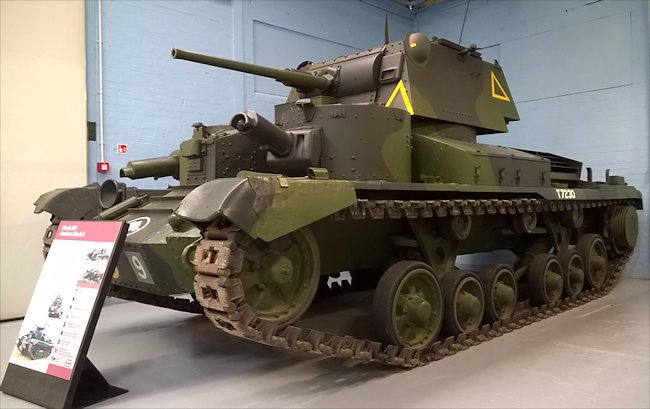
A9 British Cruiser MkI tank at the Tank Museum, Linsay Road, Bovington, Dorset
Location
This A9 British Cruiser MkI tank is on show at the Tank Museum, Linsay Road, Bovington, Dorset. The nearest train station is Wool Railway Station. You can walk the 2 miles to the Museum but there are not pavements along the country road and if you are travelling with children it can be dangerous. It takes 45 minutes by foot. There is an irregular bus service from Wool Station that will get you to the museum but they only come once an hour in the morning starting after 9.30.
The last bus back to the station from the Tank Museum is just after 13.45 which is really silly. There is no Sunday bus service. The easiest way to get to the museum from the train station is by taxi. They can be pre booked with Garrison Cars to meet you when your train arrives and pick you up for the return trip from outside the museum. Their phone number is 01929 463395
Specifications
The official name for this fighting vehicle is Tank, Cruiser Mark I. It was designed in 1936 originally as a Medium Tank with the official designation A9 but was described as a Cruiser Tank when it entered production in 1937. It was powered by a reliable but under-powered AEC Type A179, 6 cylinder petrol engine that produced 150 hp. It had a maximum road speed of 25 mph (40 km/h) and an operational range of around 150 miles (241 km). It weighed 12.75 tons and had a crew of four. They were protected by armour that ranged in thickness between 6 mm to 14 mm
It was armed with a 2pdr QFSA quick firing anti tank gun that could only fire AP armour piercing rounds not HE high explosive shells. It also had three .303 Vickers machine guns. One was positioned in the turret next to the main gun and the other two were in individual armoured turrets in the front hull section either side of the driver. They were built by Vickers and the ship builders, Harland and Wolf in Belfast. Only 125 A9 tanks were built.
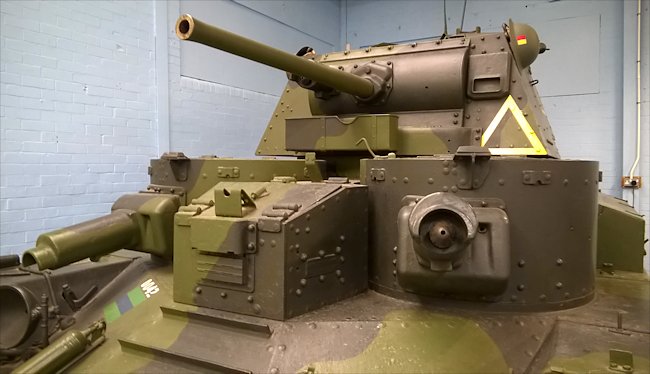
The A9 British Cruiser MkI tank was armed with a 2pdr main gun and three .303 Vickers machine guns
The Bovington A9 Cruiser Mk I tank
There are only two surviving examples of this tank left in the world. The other is at the Indian Armoured Corps Museum, Ahmednagar, Maharashtra, India. This tank carries the markings of the 3rd Royal Tank Regiment in the 1st Armoured Division that was sent to France in 1940 as part of the British Expeditionary Force. A9 Cruiser Mk 1 tanks saw action when the Germans invaded the low countries and France in 1940. Those that were not knocked out by enemy shells were abandoned at Dunkirk during the retreat.
In 1936 when this tank was designed, the 2 pounder QFSA gun was probably the most powerful anti tank gun for its size in the world at that time. In 1940 and 1941 its AP armour piercing (40mm) rounds could penetrate the armour plating on all German and Italian tanks. The turret even had a power travers that was an advanced technological feature in 1936. It enabled the gunner to lock on to a target much faster than us1ng manual hand operated wheels and gears.
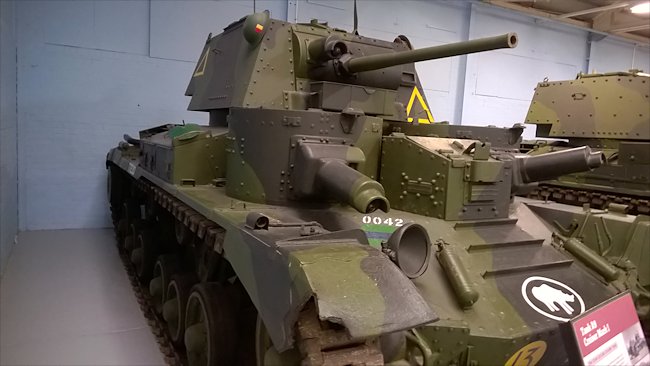
A very bad design feature of the A9 tank was where the machine gun turrets met the driver's armoured head box, enemy shells would get trapped and explode
A major weakness of the 2 pdr QFSA gun was that it could not fire HE high explosive shell that were needed to destroy enemy artillery, anti-tank guns and soft skinned vehicles. The British War Office didn’t consider this to be a problem. The A9 was a ‘Cruiser Tank’ and intended to fight enemy tanks. Concentrations of enemy infantry and guns would be left to specialised 'Infantry Tanks'. Early experience against German combined arms tactics in the desert in 1941 showed the fallacy of this concept. German tanks were always supported by panzer grenadiers, anti tank guns, artillery and when available the air force.
To deal with this problem a few A9s were altered and fitted with a 3.7 inch (94mm) howitzers. They fired HE high explosive and smoke shells to provide cover for manoeuvres by the 2pdr armed tanks. They were attached in small numbers to squadron and regimental headquarters. The Army gave them the designation Tank, Cruiser Mk ICS (Close Support).
The auxiliary machine gun turrets that sat in front of and just below the main turret, either side of the driver's central position, were archaic in concept and had origins in World War One 'landship' style of tank design. They formed lethal shot traps. Incoming enemy shells would not be deflected away but instead penetrate easily in the 'V' shape formed where the machine gun turret curved armour met the protective flat armour plate of the driver's compartment. The round turrets made it impossible to increase the thickness of the frontal armour when it was found to be too thin.
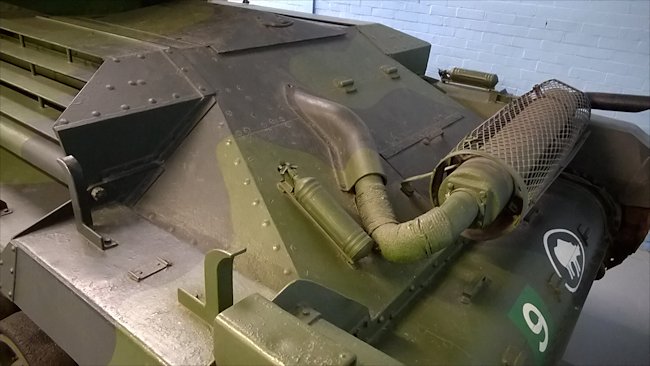
Exhaust system and fire extinguisher on the rear of an A9 British Cruiser MkI tank
A9 Cruiser Mark I tanks go to war in France May 1940
On 27th May 1940, British A9 Cruiser tank gunner Sergeant Barry Ross of the 10th Hussars, was in France, waking up to another beautiful summer’s day. They were told that they were to prepare for an attack as the German Panzers divisions that had reportedly forged a bridgehead over the river Somme near the village of Huppy, just south of Abbeville.
They were to link up with the 9th Lancers and the Queen’s Bays to chase the Hun back over the river. They were confident and ready to have go. Those that could sleep only managed a few hours in rolled up blankets by the side of their tanks.
Gunners and drivers had to man the tanks at the dawn ‘stand-to’ in case of a surprise attack, whilst the radio operator put on the tea using the standard issue ‘tommy-cookers’ and made breakfast from their rations of jam, bread and biscuits.
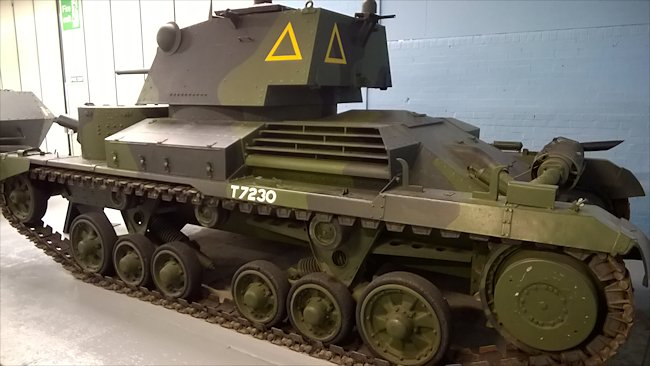
A9 British Cruiser MkI tank side view
Many of the tank crews visited their mates in other tanks to wish them luck. They approached the build up to the attack start time by actively making preparations, checking and rechecking their tank and weapons. Some larked around to defuse the tension.
The Squadron Sergeant-Major moved through all the tanks and reminded the crews to check that they have filled in the next of kin section of their pay books. That was a sobering thought and brought some of the lads playing games down to earth. This was serious. It was not another training exercise.
Mechanical problems were a big problem with the A9, A10 and A13 cruiser tanks that made up their tank division. They were very unreliable. It made crews fearful that their tank would let them down in the heat of battle and they would be sitting ducks. This did not give them confidence.
As ‘zero hour’ approached the drivers started the Liberty aircraft engine. A loud throbbing raw came from the rear engine compartment. They had been informed that French artillery would preceded their attack but what they did not realise is that the attack had been called off. Wireless communications had broken down and the Company commander never received the stand down message to post pone the attack. The French artillery barrage never happened.
German gunner Grefreiter (corporal) Wilhelm Krawzek of the 25th Infantry Regiment, was manning his 37mm anti-tank gun. His spotter, gunner Herbert Brinkforth was looking through the telescopic sight. They could hear the rumble of tanks. Krawzek remembers shouting with excitement and pointing, "There! They are working their way along, some heavy, some light, all Tommies." The A13 cruisers accompanied by some lighter A10 and A9 tanks were using the bushes and tall hedges as cover driving from one spot to the next over 1,000m away.
The British tank crews did not know they had been spotted. Krawzek counted thirty British tanks. He could not take on that amount of enemy tanks on his own. He knew his light gun would not be up to the job at that range. He gave the order to hold fire.
Nearby was a battery of 88mm Flak guns commanded by Leutnant Klay from the Abteilung I/64. These guns were initially issued to infantry divisions for anti-aircraft support but recently in Poland last September a battery of 88mm anti-aircraft guns were used to fire on a succession of attacking Polish French built tanks at place called Ilza. News soon spread through the German Army that these gun’s awesome muzzle velocity of 2.600 feet per second meant that their shells just sliced through the armour on any enemy tank.
Leutnant Klay had also spotted the advancing British tanks. "They approached hesitantly, dart to and fro like grey shadows along the edge of the wood, shudder, come to a halt, and seem not too clear about where to attack. Having identified the range we open fire. After ten shots, two tanks were in flames, burning fiercely. The penetrate force of our shells is colossal. If they achieve a square hit on target, they pierce the monster’s armour and send them up in flames. Often, when the impact is too flat, they bounce off like pebbles skimming a pond, over the tank turrets followed by a shower of sparks." As the tanks got nearer Wilhelm Krawzek also gave the order to open fire with his 37mm anti-tank gun.
A9 Cruiser tank crew member Trooper James Palmer remembers that day, "It all happened so quickly. As we topped the rise, anti-tank guns hit us from the right flank and four tanks were ablaze before we had gone ten yards. The squadron commander was trying frantically to rally the tanks, but engines stalled, men were struggling to get out of blazing tanks and some men were dragging their mates through the mud away from the burning tanks. The casualties that day were twenty killed and twenty two injured."
10th Hussars Gunner Sergeant Barry Ross recalls, "As I looked through my gun sight the rising sun blinded me and no doubt all the other crews suffered the same. It was not going to be as easy as anticipated. What a way to go into your first action: wrong information, blinded by the sun and worst of all not knowing who’s on your left flank."
The British could not see where the enemy positions were so they could not fight back. It was a disaster. They had not even encountered any German armour. The troop commander was killed by a concealed anti-tank gun. The other tanks tried to retreat out of range of the invisible German guns, zig-zagging as they did so to spoil the enemy’s aim. The A9, A10 and A13 Cruiser tank’s thin armour was no match for German anti-tank fire.
Where can I find other preserved A9 Cruiser Tanks?
- Bovington Tank Museum, England
- Armoured Corps Museum, Ahmednagar, Maharashtra, India
- Source - Pierre-Oliver Buan - http://the.shadock.free.fr/Surviving_Panzers.html
World War Two books

